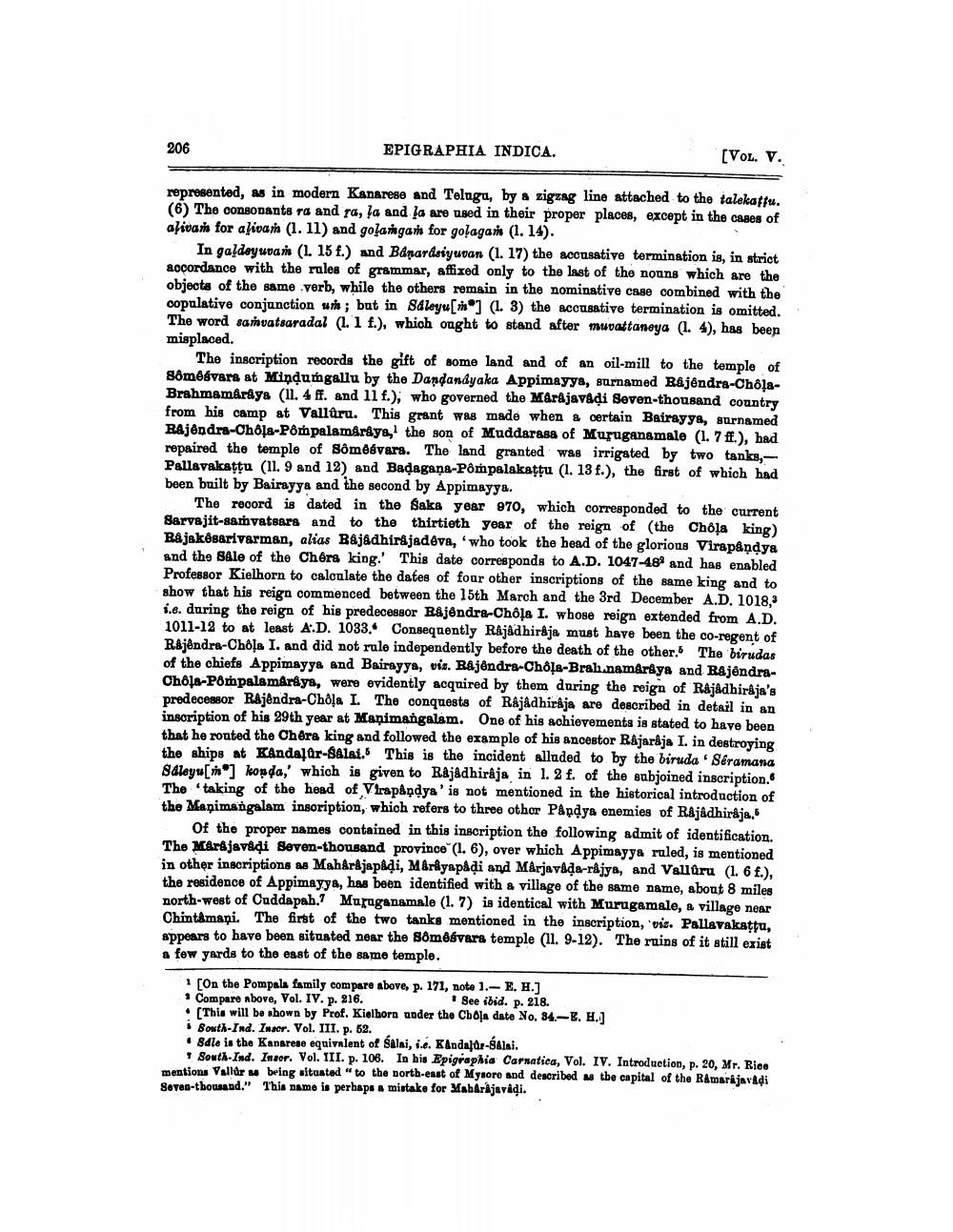________________
206
EPIGRAPHIA INDICA.
[Vol. V.
represented, as in modern Kanarese and Telaga, by a zigzag line attached to the talekaffu. (6) The consonants ra and ra, la and la are used in their proper places, except in the cases of alivan for alivan (1. 11) and golangar for golagar (1. 14).
In galdoyuvar (1. 15 f.) and Banarasiyudan (1. 17) the accusative termination is, in strict aocordance with the rules of grammar, affixed only to the last of the nouns which are the objects of the same .verb, while the others remain in the nominative case combined with the copulative conjunction wh; but in Saleyu[in] (1. 3) the accusative termination is omitted. The word samvatsaradal (1.1 f.), which ought to stand after murattaneya (1.4), has been misplaced.
The inscription records the gift of some land and of an oil-mill to the temple of Sômêsvars at Mindungallu by the Dandandyaka Appimayya, surnamed Rajendra-CholaBrahmamaraya (11. 4 ff. and 11 f.), who governed the Mârâjavedi Seven-thousand country from his camp at Vallûru. This grant was made when a certain Bairayya, surnamed Rajendra-Ohls-Pompalamardya, the son of Muddarasa of Muruganamale (1.7 ff.), had repaired the temple of sômesvara. The land granted was irrigated by two tanks,Pallavakattu (11. 9 and 12) and Badagana-Pompalakattu (1. 13.), the first of which had been built by Bairayya and the second by Appimayya.
The record is dated in the Saks year 970, which corresponded to the current Sarvajit-samvatsara and to the thirtieth year of the reign of the Chola king) Bajakesarivarman, alias Bajadhirajadeva, who took the head of the glorious Virapandya and the sale of the Chöra king.' This date corresponds to A.D. 1047-48% and has enabled Professor Kielhorn to calculate the dates of four other inscriptions of the same king and to show that his reign commenced between the 15th March and the 3rd December A.D. 1018, 1.6. during the reign of his predecessor Rajendra-Chôļa I. whose reign extended from A.D. 1011-12 to at least A.D. 1033. Consequently Rajadhiraja must have been the co-regent of Rajendra-Chola I. and did not rule independently before the death of the other. The birudas of the chiefs Appimayya and Bairayya, vis. R&jêndra-Chôļa-Brah.nameraya and RajendraOhola-Pompalamariya, were evidently acquired by them during the reign of Rajadhiraja's predecessor Rajendra-Chồla I. The conquests of Rajadhiraja are described in detail in an inscription of his 29th year at Manimangalam. One of his achievements is stated to have been that he routed the Chôra king and followed the example of his ancestor Rajaraja I. in destroying the ships at Kandalar-Salai. This is the incident alluded to by the biruda Seramana Sdleyu[t'] kopda,' which is given to Rajadhiraja in 1.2 f. of the subjoined inscription. The taking of the head of Virspåndya' is not mentioned in the historical introduction of the Manimangalam insoription, which refers to three othor Pandya enemies of Rajadhiraja.
Of the proper names contained in this inscription the following admit of identification. The Marajavadi Seven-thousand province (1.6), over which Appimayya ruled, is mentioned in other inscriptions m Maharajapadi, Mariyapadi and Marjavada-rajya, and Valluru (1. 6 f.). the residence of Appimayya, has been identified with a village of the same name, about 8 miles north-west of Cuddapah.Maraganamale (1.7) is identical with Murugamale, a village near Chintamani. The first of the two tanks mentioned in the inscription, 'viz. Pallavakattu, appears to have been situated near the 8ôm svara temple (11. 9-12). The ruins of it still exist a few yards to the east of the same temple.
1 [On the Pompala family compare above, p. 171, note 1.-E. H.] Compare above, Vol. IV. p. 216.
See ibid. p. 218. • [This will be shown by Prof. Kielborn under the Chola date No. 84.-E. H.] i south-Ind. Inscr. Vol. III. p. 52. • 8dle in the Kanarese equivalent of salai, i... Kandalur-Balai.
South-Ind. Insor. Vol. III. p. 108. In his Epigraphia Carnatica, Vol. IV. Introduction, p. 20, Mr. Rice mentions Vallar m being altoated to the north-east of Mysore and described as the capital of the Ramarajavadi Seven-thousand." This name is perhaps a mistake for Mabrajavidi.




